ReVia has been on the market for over two decades and is still being actively used today to treat a variety of conditions. But before you determine if it’s right for you, there are a few things about this unique drug that you should know first.
“We accept many health insurance plans. You can get your life back in order with our outpatient program today!”
1. ReVia is Used to Treat Both Alcoholism and Opioid Dependency
That’s right – two of Idaho’s biggest problems can both be treated by a single drug! Studies have shown that physicians have seen a lot of success in prescribing ReVia for alcohol and for opiate addiction, markedly more than that of placebo. Some people even believe ReVia’s effectiveness may extend to other diseases like fibromyalgia and (in the views of some) maybe even cancer. Also known as LDN, low dose naltrexone (ReVia’s main ingredient) has garnered some attention as a possible treatment but significantly more research still needs to be done on the topic. 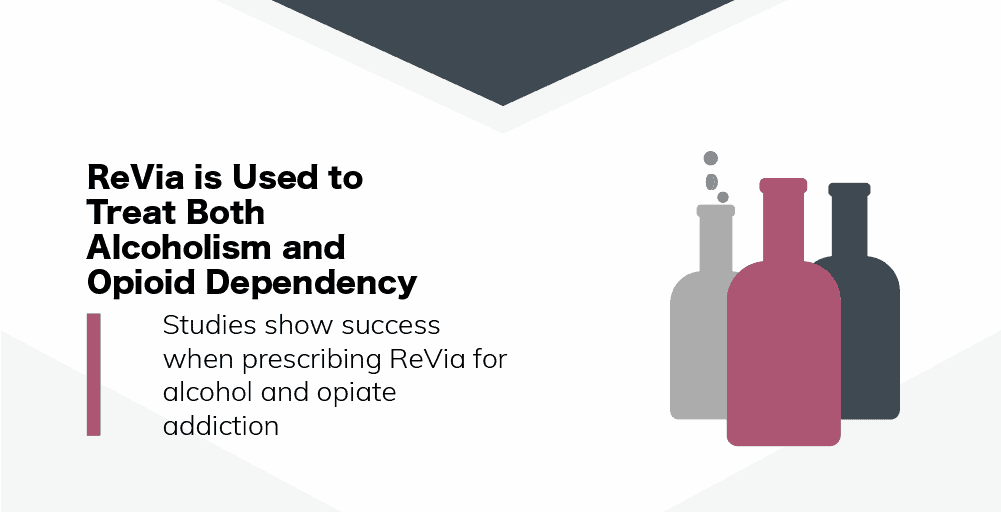
2. ReVia Is Made from Naltrexone
Well, how does ReVia work? The key ingredient is naltrexone, a unique opioid antagonist that essentially blocks out other opioids from interacting with your brain’s receptors. The result? Patients can take large amounts of opiates and alcohol without feeling any positive effects from the drugs. This is a fantastic way to keep people in recovery from being tempted to use again and makes it one of the most effective medication-assisted recovery treatments for opioid dependency. 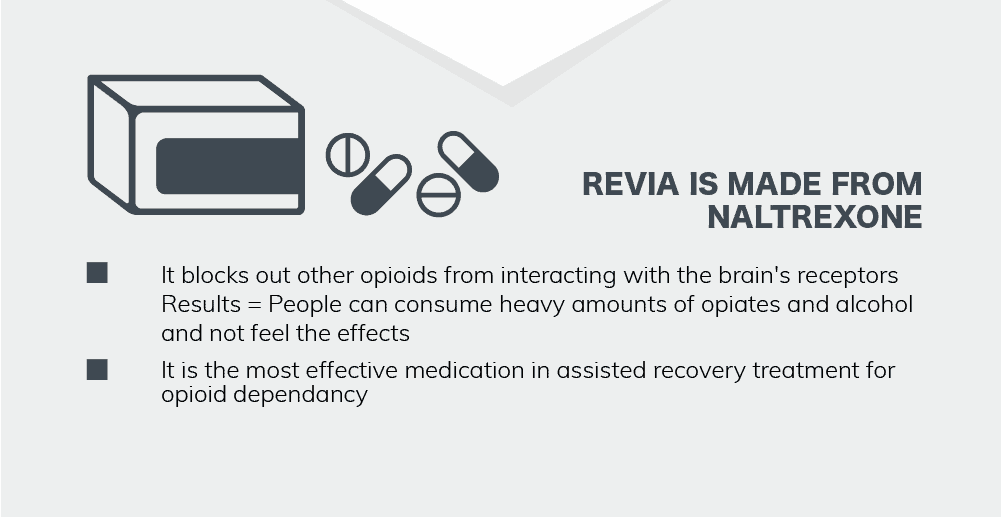
3. Naltrexone Comes in Two Different Forms
You can take naltrexone one of two ways: in pill form (ReVia) or by extended-release injection (Vivitrol). ReVia offers users more control over their recovery and is much easier to administer as patients can take the pills at home. On the other hand, Vivitrol must be administered by a licensed physician. With this level of inconvenience, you may be wondering, “Just how long does a Vivitrol shot last?” That’s the good news – one shot lasts around 4 weeks. 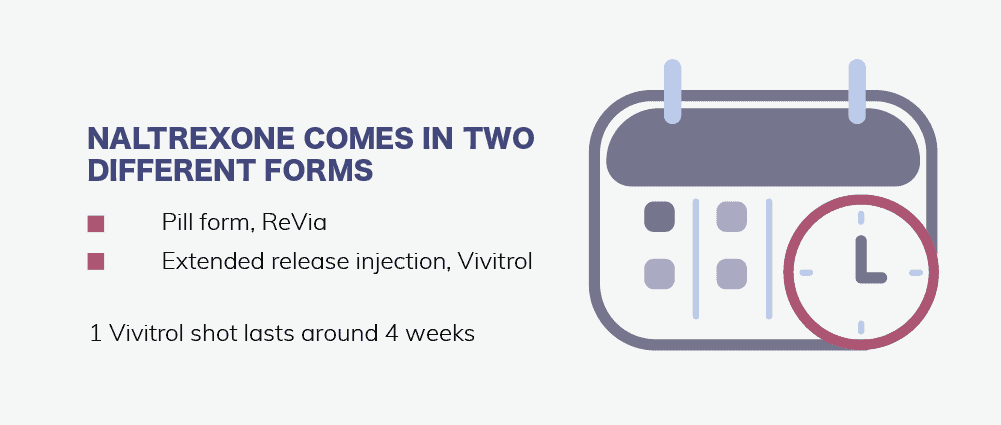
“Get the help you need today. We offer outpatient assistance, so you can maintain your work, family, and life commitments while getting the help you deserve!”
4. Naltrexone Is NOT the Same as Naloxone
Despite what many people may believe, naltrexone is far different from naloxone, another drug to treat abuse of powerful opioids like OxyContin, Vicodin, and Percocet. While naltrexone blocks the effects of most opioids entering the body (opioid antagonist), naloxone actually reverses the effects of opioids (an inverse opioid agonist). Naloxone is mainly used to revive individuals who are overdosing on opioids and is also used in some drugs (like Suboxone) as a way to deter abuse. If someone were to try to abuse Suboxone by injecting it, they would be launched into a painful state known as precipitated withdrawal. And since we’re on the subject…
5. Improperly Using ReVia and Vivitrol Can Result in Precipitated Withdrawal
Just like naloxone, the naltrexone in ReVia and Vivitrol can cause individuals with opiates still in their system to go into precipitated withdrawal. Like the name suggests, this state is basically the same as opioid withdrawal (which is incredibly uncomfortable) but is brought on almost immediately rather than gradually. As such, it’s absolutely crucial that anyone taking ReVia for alcohol or opioid dependency is completely clear of opioids in their body. Most physicians prefer to wait around 7 to 10 days since the last opiate dose, just to be sure. 
6. ReVia Has a Variety of Side Effects
The physical ReVia side effects are quite extensive. They include:
- Cramping
- Headache
- Nausea
- Vomiting
- Lethargy
- Joint pain
- Chills
- Constipation
- Diarrhea
- Dizziness
- Cough
- Sexual problems
As far as protracted problems go, liver damage, arthritis, and respiratory infections are also side effects of long-term ReVia use. 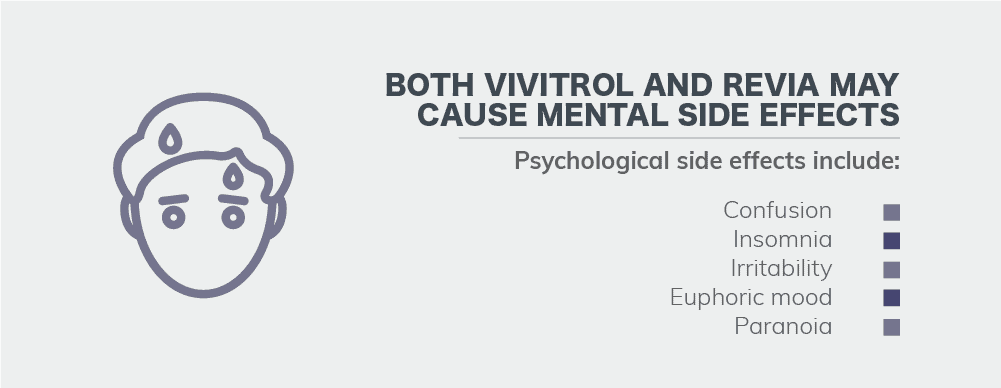
7. ReVia Can Be Used for Years
ReVia and Vivitrol are not habit forming and, as such, have the potential for long-term use. Depending on individual need and the severity of addiction, some patients may be comfortable taking ReVia and Vivitrol literally for years. As mentioned before though, there are a few health complications that can arise from extended use.
8. Naltrexone Can’t Help Your Withdrawal Symptoms
One of the most common misconceptions about drugs like ReVia is that it can help eliminate withdrawal symptoms from alcohol or opioids. This is not true. ReVia blocks certain chemicals like opiates from attaching to opioid receptors – nothing more, nothing less. In order to decrease the severity of withdrawal symptoms, you would need a partial opioid agonist like that found in Suboxone. Mistaking the two can lead to a variety of problems and a significantly decreased chance of recovery.
9. Vivitrol and ReVia Do Not Mix Well with Narcotics
Many people wonder, “Can you get drunk on ReVia?” As mentioned, Vivitrol and ReVia block the effects of certain drugs in the brain. Attempting to get high or drunk while on either of them likely won’t give you any beneficial sensations. However, they only can hold back a certain amount. As such, some patients may try to overcome the blockade by ingesting more of a drug than usual. The problem here is that the amounts needed to produce this effect are often dangerously high. In fact, a significant number of people have actually overdosed trying to overcome that barrier. ReVia’s alcohol interaction, then, has the potential to be fatal. And as with many other medications, mixing naltrexone with substances of abuse simply is not worth the risk. 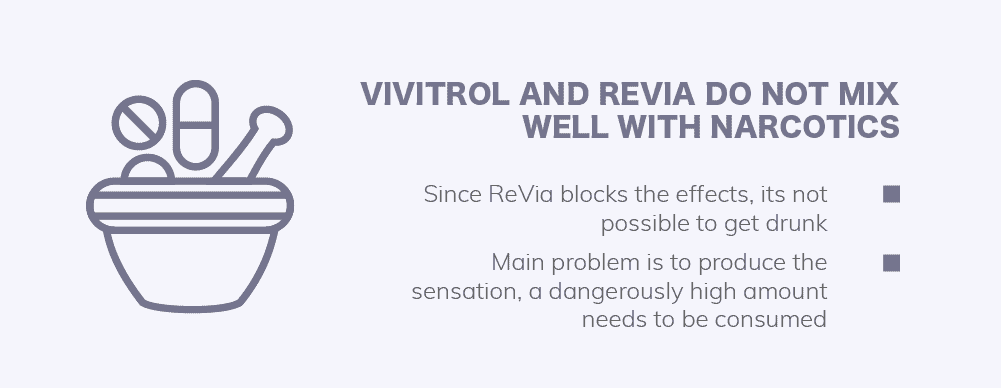
10. ReVia Isn’t as Effective as Other ORTs
Studies have shown that the two most effective methods for opioid replacement therapy and overall recovery are buprenorphine and methadone. When compared to naltrexone, these therapies have a success rate that can be two to threefold more. Part of the reason for this disparity is patient unwillingness to continue treatment. However, some physicians argue that we simply aren’t prescribing it properly. More research still needs to be done.
“We treat both addiction and co-occurring disorders and accept many health insurance plans. Take a look at our outpatient program today!”
11. Using ReVia for Addiction Is Only PART of a Complete Recovery Program
Similar to misconceptions about other mediations, some people believe that the only factor in successful recovery is just continuing to take ReVia. But the truth is, there’s a lot more to leading a sober life than simply taking a pill every day. In fact, battling the physical symptoms of withdrawal and the subsequent cravings is just the first step in a balanced and complete recovery program. The real work begins in counseling and getting to the heart of your addiction. Why did you start using in the first place? What kinds of changes do you need to make in your life to be able to cope without the help of drugs? These are just some of the questions you’ll need to ask yourself before you can make a full recovery. As such, finding a treatment program that not only offers detox services but also counseling is essential for your success.
12. Naltrexone Can’t Help Your Cravings
Unfortunately, ReVia and Vivitrol are only helpful when it comes to disincentivising continued drug use. Similar to how it can’t help treat your symptoms of withdrawal, ReVia also won’t do much to satisfy your cravings for alcohol or opiates. But keeping in line with the last point, learning how to react to your cravings responsibly and find ways not to act on them is one of the key lessons any credible treatment center will show you during rehabilitation. Some facilities may teach you techniques for dealing with stress, becoming more mindful, or other positive behaviors that support recovery. No matter how you overcome them though, the best way of doing so is by finding non-medicated methods you can put into practice on your own.
13. ReVia Might Lower Your Tolerance Over Time
Another important point of note when it comes to using ReVia for addiction is that it has been shown to reduce tolerance when taken over long periods of time. And in a perfect world where people didn’t end up relapsing, this wouldn’t be that much of an issue. But unfortunately, 40 to 60% of people with a substance use disorder do end up relapsing. With a lowered tolerance, the risk of overdosing is far more pronounced. And if you aren’t aware of this quality and decide to go back to using at the same levels as before, it may end up being a fatal mistake.
14. Both Vivitrol and ReVia May Cause Mental Side Effects
While the physical side effects of naltrexone can be quite pronounced in both ReVia and Vivitrol, both of these drugs also come with a handful of mental side effects as well. Some of the most notable psychological side effects include:
- Mental depression
- Confusion
- Visual, auditory, or sensory hallucinations
- Anxiety
- Insomnia
- Irritability
- Decreased libido
- Abnormal dreams
- Delirium
- Euphoric mood
- Paranoia
- Abnormal thinking
Some users also reported that they had an increase in suicidal ideation, also known as suicidal thoughts. As a result, some patients have ultimately committed suicide while on naltrexone in the past. And though this response to the drug is extremely rare, the severity of the symptom makes it one worth mentioning. Plus, when you combine these symptoms with those of post-acute withdrawal, the mental burden can be quite intense. 
15. ReVia Has No Potential for Abuse
One of the most appealing characteristics of ReVia and Vivitrol is the fact that they don’t carry with them the risk of being abused. As opioid antagonists, the only real effect that they have one the body is the blocking of the beneficial side effects of opioid and alcohol use. If, for instance, you’re looking to get high, there’s no amount of ReVia or Vivitrol that you can take to achieve anything remotely close to feeling high. Other opioid replacement therapy medications like buprenorphine and methadone, on the other hand, are actual opioid agonists. Rather than blocking these receptors then, they actually activate them and thus can produce effects like euphoria. As such, physicians are far quicker to prescribe ReVia over other drugs that actually have a potential for abuse. 
16. Naltrexone Is Much More Accessible Than Comparable Medications
Given that naltrexone does not hold the risk of abuse, it is far more accessible than other drugs as a result. For instance, withdrawal treatments like Suboxone or Subutex can only be prescribed by specially licensed physicians because they contain buprenorphine which can be and has been used as a substance of abuse. What’s more, these physicians can only prescribe such drugs for 30 to 100 of their patients by law. This limit was put into place to try and counteract the tendency to overprescribe this dangerous drug. And when it comes to methadone, only certain facilities operated under strict controls are allowed to treat patients with this substance.
17. ReVia Is Not an Opioid Itself
And finally, ReVia is considered by some to be superior to other treatment methods simply because it is not an opioid. This fact is important when you consider a larger debate that’s been happening in the world of recovery for quite some time. Some people think the idea of treating an addiction with an addictive substance is moving in the wrong direction. In fact, despite the proven benefits of using medication assisted treatment plans, some institutions, individuals, and even entire countries think that it is only making the problem worse. And though the science doesn’t agree, they occasionally fight to enact laws that make this effective form of treatment more difficult to obtain. One benefit of ReVia, then, is that it can be helpful for those who are unable to be treated with more effective means.
ReVia: The More You Know, The Better!
As you can see, there’s a lot to know about ReVia before you consider using it to treat your opioid or alcohol dependency. And although you and your doctor will undoubtedly discuss all the specifics during your consultation, it never hurts to get a little bit of background knowledge beforehand!
What Did you Think About This Blog?
Give it a Rating!

